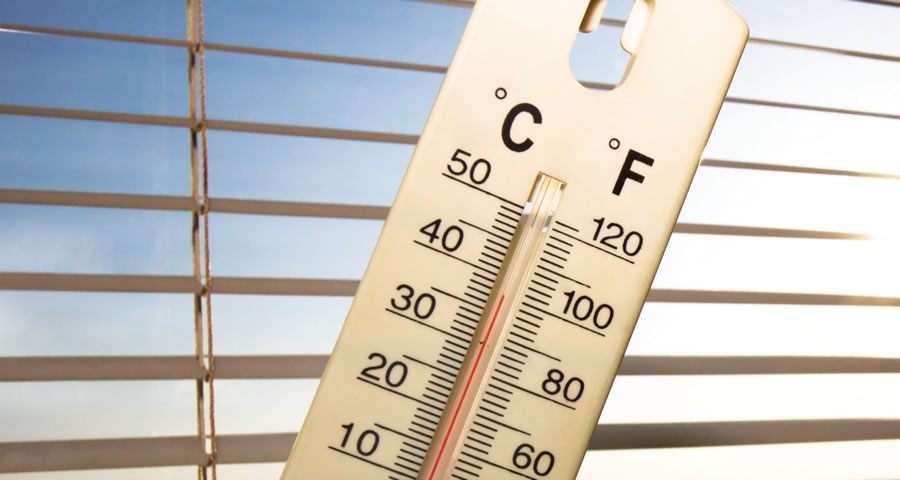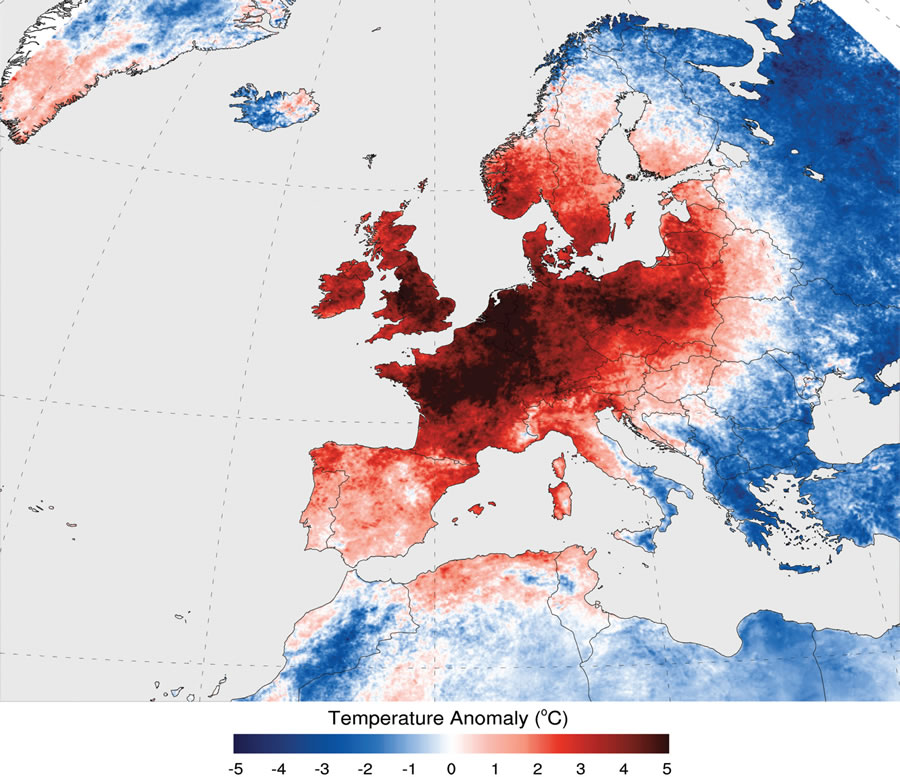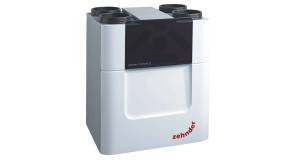
- Insight
- Posted
Overheating - a growing threat that mustn't be ignored
As the climates gets warmer, overheating in buildings is likely to get worse — particularly given the modern architectural preference for huge expanses of unshaded glass. But what really causes overheating, is it really worse in low energy buildings, how do passive houses fare, and what can be done to prevent it?
In 2011, England's Health Protection Agency officially described overheating as a public health issue. (i) Since then, a number of reports and studies have emerged making it clear the problem is not uncommon. Some instances have been severe, making news headlines, and some have had serious consequences for building developers as well as the occupants, with protracted legal disputes reported.
Despite the temptation after a summer like 2015 to say “overheating – I wish!”, this is not a trivial issue. Death rates start to rise when peak outdoor temperatures climb to around 24C. And in less heat-inured areas like the north-east of England, death rates start to creep up even at 20C.(ii)
Given that people, especially the frail and vulnerable, spend most of the time indoors, there is little doubt that indoor overheating drives these impacts. One survey in England found that 20% of bedrooms were exceeding the recommended CIBSE limit of no more than 1% of night time hours above 26C, even in an average year. Occasional properties suffered indoor temperature peaks above 30C. Nighttime temperatures above 24C impair sleep and are likely to pay a big role in the extra illness and mortality associated with warm weather.(iii)
And even for dwellings that don’t currently overheat, there is a real danger that they will do so in future. By the 2040s, summers as hot as 2003 — when over 2,000 excess heat-related deaths occurred in the UK — are expected to be very common, with one potentially every other year.
Rob McLeod of the BRE calculated that in 30 years' time, in warmer summers most low energy dwellings as currently designed will frequently experience temperatures above 28C.
There is no statutory definition of overheating in the UK or Ireland at present, however, three possible definitions are listed in the table below.

Overheating is an energy issue as well. Reportedly around 3% of the housing stock in England has airconditioning (iv), and the danger is that this will become the norm if overheating isn’t better prevented.
Media reports and indeed some in the industry point the finger of blame squarely at low energy building – specifically insulation, and sometimes airtightness too. Professor Li Shao, of Reading University was quoted in the Daily Mail (v) recently as saying: “If you wear a thick coat in winter that makes a lot of sense. But if you wear the same thick coat in summer you will overheat. It is very, very obvious...If you super-insulate houses, then you’ll create overheating issues where people will suffer.” Lightweight construction is also blamed.
However according to housing associations and local government officials, as quoted in a 2014 Good Homes Alliance report on overheating (vi), dwellings of all ages and conditions suffer from overheating — it's not just low energy buildings. A bedroom with an uninsulated roof or west-facing wall may become very hot by the end of the day, and the fabric may go on radiating heat all night.
By contrast a low energy dwelling will gain little or no heat through the roof and walls, but if solar and internal gains are not controlled, and/or ventilation is inadequate, the dwelling is also at risk of overheating. It is overheating in low energy dwellings that has been receiving the attention, most recently via a study and series of reports by a working group at the Zero Carbon Hub in the UK.
Analysis tools
The Passivhaus Trust agrees that summer overheating “can be a potential problem in all modern buildings because of our preference for much more glazing than in former times.” (vii) However, the trust also points out that passive house “is better at addressing this than any other method because it takes account of solar gain and shading as standard within its calculation methodology, and alerts the designer to any potential overheating, enabling it to be eliminated at design stage.”
An overheating check, called Appendix P, has also been introduced into the UK’s SAP methodology. The assessment is not compulsory, but the checks are nonetheless commonly undertaken during the design of new homes, sometimes at the instigation of the client.
Sadly however, according to Susie Diamond of building physics consultancy Inkling LLP, who contributed to the Zero Carbon Hub’s report Overheating – the Big Picture: “It is widely accepted that Appendix P is a bit of a fudge and needs improvement.”
The ZCH’s industry working group considered Appendix P too easy to pass partly because it “allows assumptions to be included that are unrealistic. For example, that windows are constantly open.”
With a similar Part L, and an overheating check in DEAP (Ireland's equivalent to SAP) that is much the same as in SAP (it’s no coincidence that it’s also called Appendix P), the situation in Ireland is basically the same, according to Corkbased passive house architect John Morehead. “Part L does not really address overheating – it is much more geared in relation to losses. And Appendix P is optional, and it does not really do anything,” he says.
“As a result we are seeing supposedly low energy buildings that are very uncomfortable; it is a problem. We changed over to using PHPP instead, as it addresses overheating much better, it’s much better at warning when you have too much glazing, which I believe is one of the principal problems.”
However, even if Appendix P was an accurate tool for predicting overheating, DEAP and SAP are not design tools, they are compliance tools. By the time someone starts entering the data, they are likely to be under a lot of pressure to fit the predictions around the existing design.
One of the architects participating in the ZCH research complained that “the problem with the design tools is that you tend to apply them when the design is fixed... you are running the SAP calculation to demonstrate compliance.”
The architect added: “...to be told late in the process that you’ve got an overheating risk is not very helpful.”
Perhaps the solution lies in the architect’s own hands – to establish whether or not there is an overheating problem earlier in the process, while there is still time to do something about it. This is why the Passivhaus Trust, and all good passive house certifiers, recommend that building design is modelled in PHPP at the earliest possible stage (viii).
The Trust’s Rules of Thumb document also reminds designers that while PHPP is a good tool, it still depends on the common sense of the designer to enter realistic assumptions, using common sense and good judgement.
Ventilation
In Appendix P, an effective air change rate for natural ventilation via windows is set by a lookup table depending on the degree of window opening (as entered by the assessor) and the type of dwelling. In PHPP the calculation is more nuanced, with actual window sizes and positions included, and allowances made for different ventilation patterns by day and by night.
But nevertheless, as passive house certifier Warm says in a blog post on its website, “it is easy to apparently solve any overheating problem by assuming a high enough ventilation rate”. (ix) There is simply no substitute for common sense and local knowledge. As the Zero Carbon Hub points out: “Occupants are sometimes either unable or unwilling to open windows, and leave them open for sufficient time... for a variety of reasons. These include concerns about security, pollution and noise, especially at night.” And an urban heat island (and this can be a very local effect) may drastically reduce the amount of cooling available.
As Susie Diamond adds, even where none of these issues apply, “you can’t just blow air at 15C over the occupants all night – they will get cold. It’s OK in an office when there’s nobody there, but if there are people, especially vulnerable people, sleeping, you can’t treat them the same way.”
It is important to be realistic with mechanical ventilation too: passive house consultant Alan Clarke warns that even on summer bypass mode, MVHR will still recover around 25% of heat, so for an accurate figure in the overheating calculation in PHPP, the air change rate should be reduced by one quarter.
But a highly insulated and airtight building with heat recovery ventilation may have an additional advantage in very hot weather. If the building is closed up and glazing is adequately shaded, it can stay cooler during the day than its conventional equivalent.
If the building has cooled during the night, turning the summer bypass off – in other words, restoring heat recovery – will recover the coolness and keep it in the building. Some MVHR units come with this built in as automatic, restoring heat recovery at a preset indoor temperature – for example, 22 or 23C – if it detects that the incoming air is hotter than this. However, this approach only works when the windows are closed.
Internal gains have been implicated in overheating in small dwellings: homes in the UK tend to be quite a bit more densely occupied than those in continental Europe, leading to higher occupantrelated gains per square metre. PHPP now sets different internal gains for winter and summer, to stay on the safe side in each case. For summer it uses the actual gains set by electrical appliances, auxiliary energy and hot water losses for the actual number of occupants, and for the services as designed.
Ventilation and thermal mass
There is sometimes concern that relatively light constructions such as timber frame are more vulnerable to overheating – and that this can be resolved by increasing the thermal mass.

While not as lethal as the 2003 heatwave, which was estimated to have caused 70,000 deaths across Europe, the 2006 European heatwave saw temperature records broken in several countries, including the UK and Ireland, while 1000 deaths were attributed to this event in the Netherlands alone.
Image: Giorgiogp2
However thermal mass is not a panacea, and cannot simply be added in to ’compensate’ for gains from extensive glazing. As Alan Clarke warns, there is a limit to the amount of heat that can be purged from thermal mass via ventilation. He says: “The thermal capacity of air is not that high, and the thermal inertia of materials restricts the rate at which heat can be lost.
“Thermal mass is fine if purging [of heat] can be fast enough, taking onto account likely evening/night time temperatures. A lighter structure, while it will get hot during the day — especially if not ventilated — can be fully cooled at night, so will be cooler for sleeping. It will also be less liable to build up heat day after day in an extended hot spell.”
Susie Diamond agrees: “The commonest problem with overheating is where dwellings get a lot hotter than outside during the day, and are not able to cool down overnight.
“If a building is sealed up all day when people are out and the temperature rises to 40C, so long as it cools down within say 20 minutes of people returning home and opening all the windows, that’s probably OK. But if it doesn’t cool down quickly, that’s not all right.
“This is one of the problems with people assuming that thermal mass is an antidote to overheating. In fact if there is a lot of mass, flushing all that heat out may be difficult, especially if for example the building is single aspect, single storey, or the windows do not open very wide. If there is too much mass you can’t purge it fast enough, and it simply re-radiates the heat through the night.”
Perhaps the most common design problem in buildings that overheat is excess glazing, especially to the south and west. In a non-passive house building this may just be because the client or architect likes huge windows, or perhaps believes that they signify luxury. However in a passive house, extensive south glazing may be there specifically to capture passive solar gains in winter. And there is no doubt that a lot of glazing means a lot of gains – which will then have to be removed if overheating occurs.
According to passive house consultant Nick Grant, it may even be that with very large windows, the effect of shading may be reduced in summer by convection currents circulating between the sunlit and shaded portions of the unit, heating the inside surface of the window.
Furthermore, as Warm warn on their blog, shading calculations are very tricky. “We think it’s actually impossible to get the shading 100% ‘right’ in PHPP,” they say. This is especially the case with user operated shading, as it is impossible to be certain if or how it will be used.
Warm advise that a design dependent on large amounts of south glazing is inherently less robust than one achieving its thermal performance with lower levels of glazing – in summer and winter. (x)
To prevent overheating, Rob McLeod of the BRE has a suggestion for passive house designers. Aiming to minimise the spacing heating demand over the whole season, working to the 15kWh/m2/yr target in PHPP, can tempt designers to maximise solar gain. But this clearly also carries risk of overheating when conditions are warmer (as well as increasing the risk of losses when conditions are coldest).
McLeod suggests designers work instead to the alternative certification target of a peak heat load of 10 W/m2. This focuses more on insulation and reducing heat loss, since the peak heat load will occur at a time of very little solar gain. So in this case windows can be become a net loss, and a much more modestly glazed design results, which reduces the risk of overheating.
A building designed in this way may have the additional benefit of being cheaper, and being less vulnerable to last minute issues with super expensive high-performance glazing.
Climate data
SAP and PHPP both divide the UK into a number of climate zones to give average levels of temperature, wind and solar radiation. For Ireland, PHPP contains two climate data sets. But architect John Morehead has examined ultra-local climate data for different parts of the country and has found that when these specific values are entered into PHPP, annual heat demand and heat load can vary by as much as 45% for geographical areas — even on an island as small as Ireland.
This makes a significant difference both to optimising the design for warmth in winter, but also when guarding against overheating in summer. “For example, using the local data has allowed [us] to ease the U-values depending where the building is situated — here in Cork our winters are much milder than in the centre and east of the country, but the summers are cloudier. This means we can use more south glazing without so much worry about either losses or overheating,” he says.
“The local certifier is happy for us to use this data for [solar] gains, then we use the Dublin data for heat loads as they are more demanding; that way everyone is happy. But in the end, this is not so much about getting the building certified, we are much more interested in making the building work.”
Beyond the drawing board
There is still one big assumption that all designers are making though. However careful their calculations on building performance might be, they are assuming that what they have designed is what will be built. This does not always happen.
For example, the PHPP calculations for a development of semi-detached passive houses in Scotland determined that there would be just 0.2% overheating, ie three quarters of one day per year above 25C.
Yet monitoring showed a period of two weeks when the temperatures in the bedrooms rarely dipped below 25C, despite external temperatures averaging about 18C. As a report by Tim Sharpe and colleagues at the Mackintosh School of Architecture put it: “This represents a significant mismatch between PHPP assumption and reality.” (xi)
A number of issues with the construction were identified. One particular source of unwanted internal gains was uninsulated pipework that ran behind the upstairs walls, connecting the solar thermal panels to the main heat store.
Also, the project did have quite a complicated specification for the building services which included a wood stove for space heating and winter hot water as well as solar thermal.
What next?
Awareness of overheating is definitely increasing. So what practical steps are being taken to tackle the issue at source?
If campaigners succeed in bringing in passive house as the mandatory building standard in Dún Laoghaire-Rathdown and Dublin City, then a much more detailed overheating analysis will be carried out for all new buildings there. However for Ireland as a whole, and the UK, statutory action seems unlikely.
But as Susie Diamond explains, industry itself has reasons to want to change things. “Housebuilders themselves are taking a positive interest in this, as they are starting to feel at risk,” she says.
“There was concern from housebuilders that a design could apparently 'pass' the overheating test in SAP, only to overheat and leave them facing a dispute, and possibly considerable expense. They are coming to the point where they would rather spend a bit more on the design than get into this situation.”
One example that was reported to Diamond’s working group at the ZCH was that of a housebuilder who ended up carrying out extensive remedial works on a recently completed building, “in order to gain building control sign-off and to satisfy the local environmental health officer.”
According to the Hub’s report, even winter temperatures in these apartments exceeded 27C. “During this time, the housebuilder experienced negative media coverage and customer dissatisfaction.” They ended up spending around £100,000 on remedial work.
“If there was an agreed protocol for predicting overheating, then builders could argue that they had followed this protocol and therefore they were not at fault,” Diamond says.
She hopes that such a protocol will be developed, and feels there is a lot to learn from the passive house community: “They tend to be quite ‘real’ and pragmatic; we are hoping to have continuing involvement from passive house people in developing this work.”
Meanwhile, the passive house community itself is not standing still either. Members of the Passivhaus Trust have charged its technical working group with investigating overheating in passive house builds. Certifier and Passivhaus Trust associate director Kym Mead reports that the trust is likely to recommend that designers aim for no overheating, but that 0 to 2.5% of the year above 25C could be considered very good practice; 2.5 to 5% good practice and 5 to 10% merely a backstop result. “The general opinion is that the [PHPP] criteria set at 10% hours over 25C are too high,” he says.
“We are learning more and more about how to build passive house in the UK climate,“ he says, and suggests we should be aiming for zero overheating. “These proposals comes out of the collective will to get this right.”
After all, in the end good building is about far more than certification, it is about comfort, about health, and about satisfied occupants.
References
iOverheating in Homes: The Big Picture, Zero Carbon Hub 2015
iiSame as above
iiiAn investigation into future performance and overheating
risks in Passivhaus dwellings, Rob McLeod et al, Building and
Environment, Volume 70, December 2013, Pages 189 to 209
ivSame as (i)
v“Crazy eco rules that are turning modern homes into ovens:
experts warn drive for 'green' homes poses a potentially
lethal risk”, The Daily Mail, 10 July 2015
viPreventing Overheating, Good Homes Alliance, 2014
vii''Overheating risk in eco homes', www.passivhaustrust.org.uk,
11 May 2015
viiiHow to Build a Passivhaus: Rules of Thumb, Passivhaus Trust, 2015
ixhttp://www.peterwarm.co.uk/10-most-common-phpp-mistakes/
xSame as above
xiTowards Low Carbon Homes – Measured Performance of Four
Passivhaus Projects in Scotland, Tim Sharpe & Chris Morgan,
at Eurosun 2014, 16-19 September 2014, Aix-les-bains, France.
Stress testing your design
One way to gain more confidence about the accuracy of your overheating results (or indeed, about any aspect of your passive house design) is to run a stress test, where plausible extreme conditions are entered into the relevant sheet, to see if the results are a catastrophic failure of performance – or merely make the building slightly less comfortable.
Thus for overheating, certifiers Warm recommend the following “stress” conditions:
• minimum user operated summer shading;
• set mechanical ventilation at half normal rate;
• assume no natural ventilation during the day;
• assume half the achievable night time ventilation (and be careful about assuming internal doors are open).
Stress tests might also roughly test the possible impact of prolonged heatwaves by running the overheating analysis with climate data corresponding to a warmer area – for example, using the London data with its warmer summer nights, when designing a building outside the city. It is also possible to get hold of projected climate data to run a ‘future' stress test. Stress tests might be a useful way to compare alternative fenestration designs, for example.




